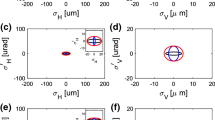Abstract
Background
Compared with the traditional monochromatic synchrotron radiation beam, a pink beam is a quasi-monochromatic beam which can be obtained by screening a harmonic of the undulator. The energy bandwidth (\(\Delta E{/}E\)) of a pink beam is about \(10^{-2}\). Despite the intensity gain from the quasi-monochromatic beam, the decrease in the energy resolution will lead the collected data to be smeared.
Purpose
To study the influence of the energy bandwidth on the small angle X-ray scattering (SAXS) by experiments and verify the feasibility of SAXS with a pink beam.
Method
Firstly, the influence of different energy bandwidths on SAXS has been studied by simulation and experiment. Then, TEM tests have been performed and compared with the experimental results.
Result
It has been shown that the scattering curves deviate slightly from the traditional monochromatic ones. This deviation does not influence the data processing for the maximum deviation of the results is just less than 2%. In return, the gain in the intensity (one to two orders of magnitude) makes the pink beam very important for the time-resolved SAXS. Further, the results of TEM and SAXS have shown an excellent agreement.
Conclusion
This work proves that the pink beam could be used for SAXS directly without a desmearing procedure. Benefiting from the increase in the beam intensity, the exposure time can be greatly shortened, thus enhancing the utilization efficiency of the synchrotron radiation.








Similar content being viewed by others
References
P. Debye, A.M. Bueche, J. Appl. Phys. A 20(6), 518 (1949)
G. Porod, Small Angle X-ray Scattering (Academic Press, London, 1982), pp. 17–51
J.S. Pedersen, Adv. Colloid Interface Sci. A 70, 171 (1997)
D. Schneidman-Duhovny, S.J. Kim, A. Sali, BMC Struct. Biol. A 12, 17 (2012)
Z.-H. Li, Chin. Phys. C A 37(10), 108002 (2013)
S. Bratos et al., J. Synchrotron Radiat. A 21(Pt 1), 177 (2014)
M. Rivers, Conference on Developments in X-Ray Tomography X. A, vol. 9967 (2016). https://doi.org/10.1117/12.2238240
O. Bilsel, C.R. Matthews, Curr. Opin. Struct. Biol. A 16(1), 86 (2006)
M. Bagge-Hansen et al., J. Appl. Phys. A 117(24), 245902 (2015)
R.L. Gustavsen et al., J. Appl. Phys. A 121(10), 105902 (2017)
R. Takahashi, T. Narayanan, T. Sato, J. Phys. Chem. Lett. A 8(4), 737 (2017)
T.M. Willey et al., AIP Conference Proceedings, vol. 1793 (2017), p. 030012. https://doi.org/10.1063/1.4971470
W. Wang et al., J. Appl. Crystallogr. A 48(6), 1935 (2015)
B.R. Pauw, J. Phys. Condens. Matter. A 26(23), 239501 (2014)
B.R. Pauw et al., J. Appl. Crystallogr. A 50(6), 1800 (2017)
S. Chen, S.-N. Luo, J. Synchrotron Radiat. A 25(2), 496–504 (2018)
E. Bergbäck Knudsen et al., J. Appl. Cryst. A 46(3), 679 (2013)
D.I. Svergun, J. Appl. Cryst. A 25, 495 (1992)
H.D. Mertens, D.I. Svergun, J. Struct. Biol. A 172(1), 128 (2010)
O. Glatter, R. Klein, P. Lindner, Neutrons, X-ray and Light: Scattering Methods Applied to Soft Condensed Matter, 1st edn. (Elsevier, Amsterdam, 2002), pp. 391–420
A. Guinier, G. Fournet, Small Angle Scattering of X-Rays (Wiley, New York, 1955)
K. O’grady, A. Bradbury, J. Megn. Megn. Mater. A 39, 91 (1983)
M. Bonini, E. Fratini, P. Baglioni, Mater. Sci. Eng. C A 27(5–8), 1377 (2007)
B.R. Pauw, C. Kastner, A.F. Thunemann, J. Appl. Crystallogr. A 50(Pt 5), 1280 (2017)
S.M. Sedlak, L.K. Bruetzel, J. Lipfert, J. Appl. Crystallogr. A 50(Pt 2), 621 (2017)
J.S. Pedersen, D. Posselt, K. Mortensen, J. Appl. Crystallogr. A 23, 321 (1990)
P.V. Konarev et al., J. Appl. Crystallogr. A 36, 1277 (2003)
W. Szczerba et al., J. Appl. Crystallogr. A 50(Pt 2), 481 (2017)
Acknowledgements
This work was supported by a grant from the National Key R&D Plan of China (Grant No. 2016YFA0401300).
Author information
Authors and Affiliations
Corresponding author
Rights and permissions
About this article
Cite this article
Wang, S., Liang, Y., Wang, B. et al. Influence of energy bandwidth of pink beam on small angle X-ray scattering. Radiat Detect Technol Methods 3, 4 (2019). https://doi.org/10.1007/s41605-018-0047-1
Received:
Revised:
Accepted:
Published:
DOI: https://doi.org/10.1007/s41605-018-0047-1




